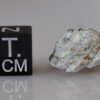Description
Rantila 24°14’26’’N, 71°46’45″E
Gujarat, India
Confirmed fall: 2022 Aug 17
Classification: Enstatite achondrite (Aubrite)
History: The meteorite fall was observed in two nearby villages, Rantila and Ravel, ~10.5 km apart. The meteorite fell at Rantila village in soft, clayey agricultural land. While falling, the meteorite hit a branch of a tree and broke into fragments, also breaking the branch into several pieces. Several fragments of the meteorite were found scattered around a field, with the larger pieces producing small pits (~28 cm diameterm ~15 cm deep) due to impact on soft, wet soil.
Physical characteristics: Broken pieces reveal a fragmental breccia. Theses pieces are fragile and the inner materials are brittle. They contain olivine, plagioclase feldspar, iron-nickel metal, and numerous sulfides. Large pyroxene grains (up to 2 cm) occur as bright white crystals.
Petrography: The dominant mineral phase is enstatite, followed by diopside, olivine, and plagioclase. Sulfides include troilite, alabandite, heideite, daubréelite, oldhamite; Fe-Ni alloys are also present.
Geochemistry: Enstatite Mg# 99.7, En98.4Wo1.0, diopside Mg# 99.8, En54.5Wo45.1, Olivine Mg# 99.7, plagioclase Or3.3Ab95.9An0.7.
Classification: The meteorite is an aubrite (enstatite achondrite) and is a fragmental breccia. Degree of shock is moderate and the weathering is minimal
Specimens: Type specimen ~200 g at PRL. Main mass with District Officials of Banaskantha, Gujarat, India








